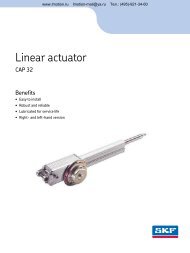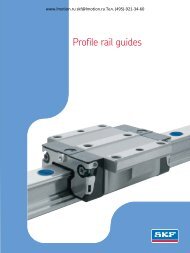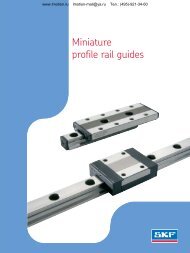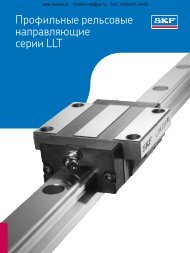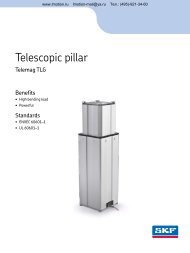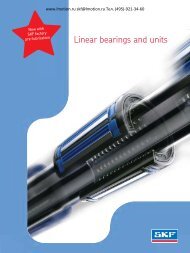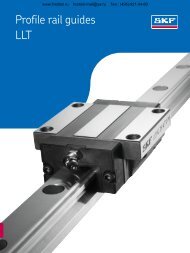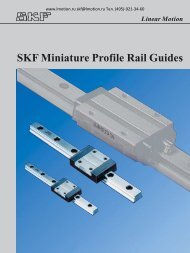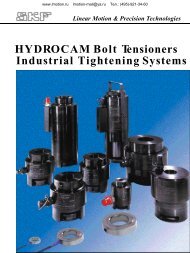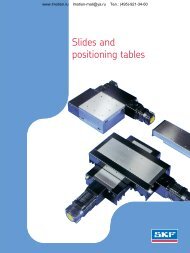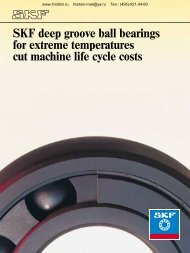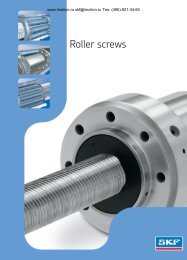Precision rail guides
Precision rail guides
Precision rail guides
You also want an ePaper? Increase the reach of your titles
YUMPU automatically turns print PDFs into web optimized ePapers that Google loves.
www.lmotion.ru skf@lmotion.ru Тел. (495)-921-34-60<br />
Accuracy of adjacent components<br />
An important criterion for the correct<br />
performance of a <strong>rail</strong> guide system is<br />
the accuracy of the associated components.<br />
The higher the demands for<br />
accuracy of guidance and for smooth,<br />
easy operation, the greater the attention<br />
which must be paid to the<br />
accuracy of form and position of the<br />
associated components. Generally<br />
the same accuracy requirements<br />
should be applied to these components<br />
as to the <strong>rail</strong> <strong>guides</strong> themselves.<br />
The adjacent table shows the<br />
values, for each tolerance class, of<br />
the surface roughness, perpendicularity<br />
and parallelism of the adjacent<br />
components.<br />
To assure an even load distribution<br />
over the roller length, the maximum<br />
difference in height of the supports<br />
for a <strong>rail</strong> guide should not<br />
exceed<br />
∆h = 0,1 · B 1<br />
where<br />
∆h = maximum height deviation, µm<br />
B1 = mean distance between two<br />
<strong>rail</strong> <strong>guides</strong>, mm<br />
To obtain good support for the<br />
<strong>rail</strong>s on the associated components,<br />
the attachment holes should be carefully<br />
deburred (Figs. 9 and 10).<br />
Selection of <strong>rail</strong> <strong>guides</strong><br />
When selecting a <strong>rail</strong> guide, the<br />
length of travel, load carrying capacity,<br />
requisite life and stiffness are the<br />
most decisive factors. Other important<br />
parameters include the requisite<br />
speed of travel, lubrication, operating<br />
temperatures, ease of movement,<br />
environmental influences and certain<br />
design constraints, for instance<br />
whether “clamped” or “floating” guidance<br />
is required. If further information<br />
is needed, please contact SKF.<br />
The selection of the size and length<br />
of the rolling element assemblies is<br />
mainly determined by the required<br />
Fig. 9<br />
Fig. 10<br />
Accuracy of form of support surfaces<br />
Characteristic Symbol for Permissible<br />
deviation of form<br />
Charac- Tolerance Dimensions Tolerance class<br />
teristic zone<br />
P10 P5 P2<br />
Roughness R a a µm 1,6 0,8 0,2<br />
Perpendicularity t 1 /t 2 µm/mm 0,3 0,3 0,3<br />
Parallelism §§ t 3 /T 4 µm depending on the<br />
guide length L (mm)<br />
3 2 1 200<br />
6 4 2 500<br />
10 6 3 1 000<br />
load carrying capacity, life and stiffness.<br />
For light, centrally acting loads<br />
and moderate demands for speed of<br />
travel, it is possible to use practically<br />
all the types of <strong>guides</strong> listed in this<br />
catalogue. However, technical and<br />
economic reasons often dictate the<br />
choice of the most appropriate model<br />
for a given application.<br />
The length of a <strong>rail</strong> guide and of<br />
the individual <strong>rail</strong>s is mainly determined<br />
by the travel as well as the<br />
length of the rolling element assemblies,<br />
which depends on the requisite<br />
load carrying capacity and life.<br />
The following relationships serve<br />
as guidelines for determining the<br />
length of <strong>rail</strong> <strong>guides</strong> and rolling element<br />
assemblies:<br />
For a given stroke:<br />
Cage length = stroke, at least<br />
For a given cage length:<br />
Rail length = cage length<br />
+ 0,5 x stroke<br />
For a given <strong>rail</strong> length and stroke, the<br />
cage length is is obtained from:<br />
Cage length = Rail length<br />
– 0,5 x stroke<br />
11



